Connecting the micro and macro of the League Secretariat
Blog entry by Torsten Kahlert (postdoc - Aarhus University)
The first thing I can remember about the League of Nations is the word ‘failure’. That’s what stayed in my mind from the not so exiting history lessons I attended at school, at least the ones of my second history teacher, who succeeded our loved first one, who got fired because of Stasi collaboration, later to be disproven. But while an organisation can fail, people’s lives have to move on.
People or actually the entirety of the permanent personnel of the first global organization, the League of Nations Secretariat, will be the focus of my research for the time ahead. But how on earth do you go about it, when there are several thousands of them and not even the exact number is accurately settled? In the very beginning of my project, which I started in October this year, a colleague advised me to have a look at a database called LONSEA ( http://lonsea.de ). LONSEA stands for “League of Nations Search Engine” and is a product of the research cluster on “Asia and Europe in Global Context” based at the University of Heidelberg. The database contains a range of international organisations and the people who worked in them in the period of 1919 to 1946.
The LONSEA database is based on material from the League of Nations itself, so I was curious to have a look at the sources and the original material, to see what I could extract from them about the personnel of the League. Soon, therefore, I went to the League of Nations archives in Geneva, to have a look into the so-called personnel files.
The microcosmos of the Secretariat
What I was looking for, of course, was information about the personnel. In one respect, the personal office of the League of Nations did not make any distinction between someone hired to take care of the garden, to translate or to direct one of the sections: No matter where you worked, everybody got a personnel file. In this sense, the bureaucratic body of the League was practicing equality. However, these personnel files could not be used until recently. They were confidential for a long time, but have been made available for research around a decade ago.
So, what is in such a personnel file? I flipped through the files of the second division. The second division can be described as the technical midlevel of the League. Here, an army of shorthand typists, verbatim reporters, stenographers, proof readers, copyists, secretaries, assistants and so on from many different countries were working. One of them was Margaret Lord, and like with everybody else, the League Secretariat kept a personnel file on her.
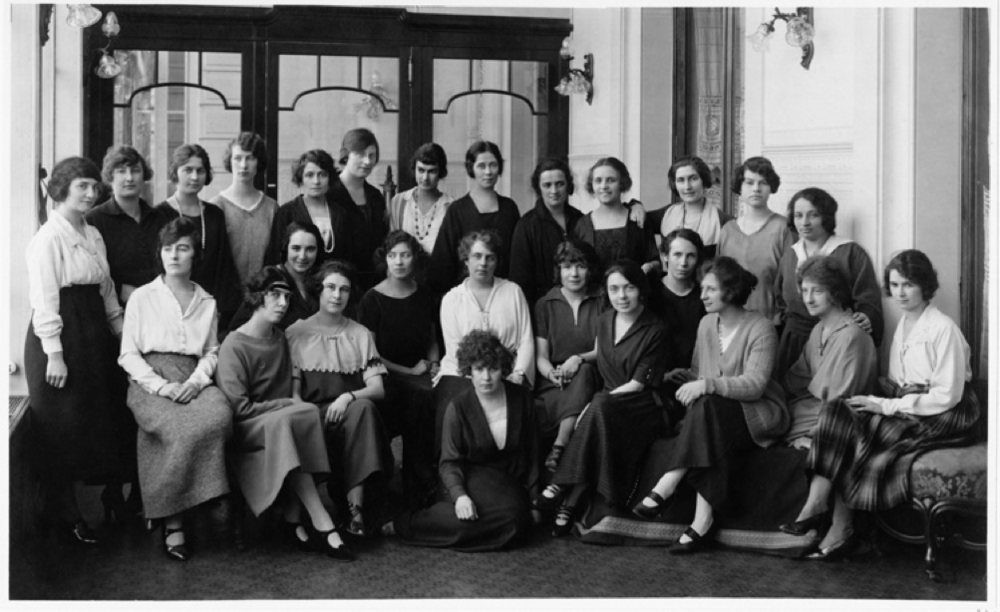
Picture of the Stenographic Service (probably 1923) original in League of Nations Archives, Palais des Nations, taken from the digitized League of Nations Photo Archive of the Indiana University, www.indiana.edu/~librcsd/nt/db.cgi= (last visited 08.12.2016)
Her file contains about 140 pages. There is correspondence from the time of her application for the job of stenographer, her contracts, documents on her salaries and her pension, reports on her work, documents of her illnesses and finally the correspondence concerning her wish to leave the League. Margaret Lord was born in Colwyn Bay, North Wales. Margaret was 27, when she was taken on by the League in 1923, first for a probationary period and later with a permanent contract. But her first letter dates from the 25th May 1919, which is not even one month after Eric Drummond had been appointed the Secretary General of the League of Nations. In this letter, which is addressed directly to Drummond, she writes, that she had been working in Switzerland before, for the British Intelligence Department, which goes a long way to explain how she got to know about the League and Drummond at this early stage, and why she thought she could do the job.
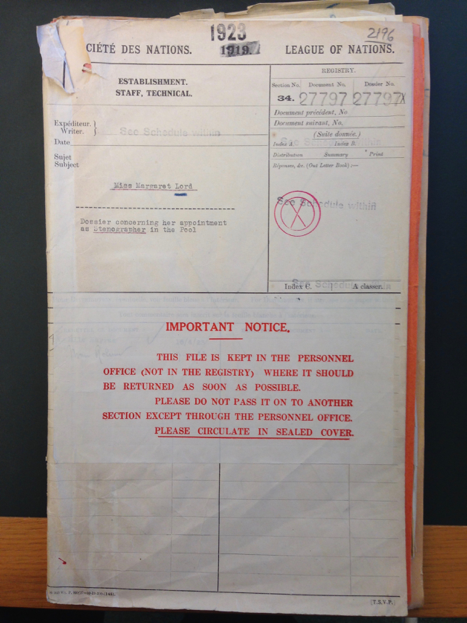
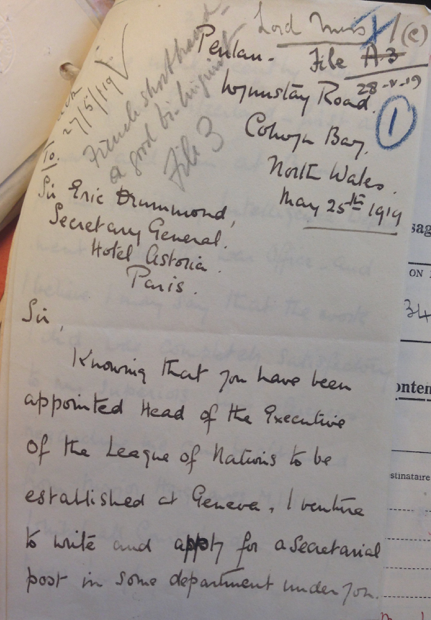
The next letter is a letter of recommendation from her former employer, who assures, that Margaret is not only “clever”, but able to write shorthand in several languages and knows the situation in Geneva. Knowledge of languages was one of the key skills required to get an appointment in the League Secretariat. Apparently, the translation test she received and sent back to London, where the League had its first offices, was unsatisfactory, and, accordingly, she got a rather disappointing reply. Instead of a post in the translation bureau, she was offered a position as a shorthand typist. This was at the end of June 1919. Then, for a while, nothing happened. In January 1920, she renewed her application, but again got a negative answer with the argument, that it was not possible to hire her for a secretary post due to “the slight predominance” of British staff at the moment. The only post available was that of assistant stenographer. Because the League could not match her salary expectations, this time the correspondence ended. But she was not forgotten. The League always needed additional temporary staff for the annual Assembly meetings and other major conferences. In 1922 she got the offer to work as a temporary shorthand typist for the third Assembly. We do not know if she accepted the offer of the temporary contract, but one year later she was offered a permanent contract.
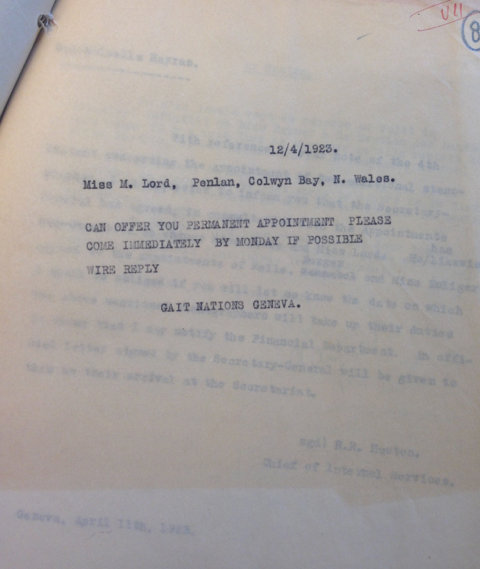
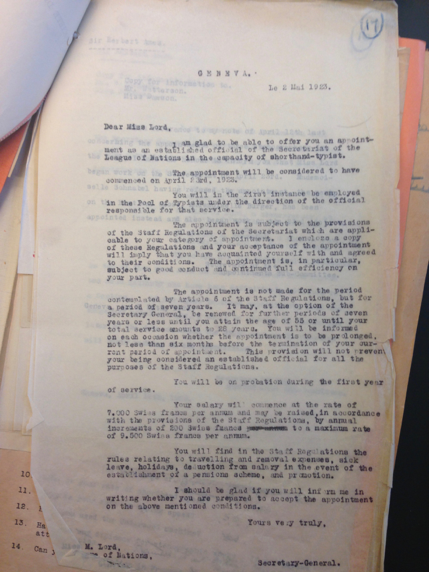
The first evaluation of her work was quite critical. It stated that her work was not satisfactory, and that the supervisor writing the report had received many complaints from translators. However, the evaluation also stated that at the latest her work had improved. And her supervisor suggested an extension of the probationary period for another half year. The next several reports on Margaret Lord’s work were very positive, so she finally got her permanent contract with the Secretariat.
But what else is in the personnel file? Margaret Lord signed up for internal tests which, if completed satisfactory, could secure promotion. She took the bi-lingual test twice, for instance, without making headway and without being chosen for a promotion. She applied for a secretary post at the Health Section, but failed to get that too. In 1926 she got ill. There is a string of letters from a doctor at her home in North Wales stating that she needed more time to recover. After some months of her being away, the League administration contemplated how to handle the length of her absence. They came to the solution to detract some of her sick leave from her regular annual leave.
In the early 1920s the League was growing as an organization on the one hand in terms of staff but on the other hand also in terms of workload. A report which was first presented in 1927 on the amount of sick leave of the personnel showed, that the amount of work was growing much more, than the personnel. That served as an explanation for the rise of days of sick leave.
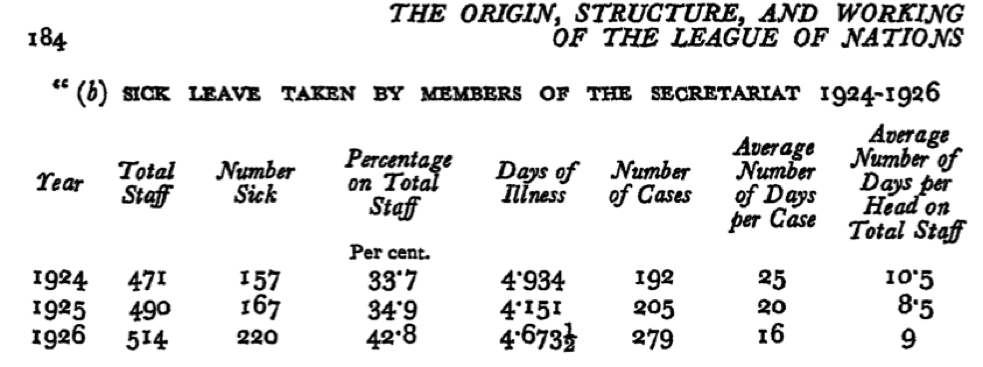
Charles Howard-Ellis, The Origin, Structure and Working of the League of Nations (London: George Allen & Unwin, 1928), p. 184.
We do not know if Margaret Lord’s story is a manifestation of this, but in autumn 1927, she asked for a leave without pay for two years. She did not come back. The last pages of the personnel file contain correspondence concerning her wish to leave the League. Margaret Lord, now married as Margaret Lywood-Lord, had gotten an offer to work for the British Refugee Settlement Commission in Athens.
From Micro to Macro – the questions remaining
This is just an example of a personnel file. Of course, the documents in it, leave many questions open concerning the personal life of Margaret Lord as well as the League Secretariat’s procedures and practices when hiring staff. But already from the quite accidently chosen example we saw the micro-perspective of some the arguments which have been made concerning the recruitment policy of the League of Nations, e.g. Drummond’s hint on the slight predominance of Brits in the League or the problem of rising sick leave which came up during the mid-1920s. But how do we know if this case is typical or not? What would be the best way to approach the archive of personnel files containing thousands of these files? At this point the database LONSEA could come back in. Findings such as this case could spur questions relevant for the whole dataset of the Secretariat’s personnel, for example the question of how old the applicants were, when they signed their first contract and how long they stayed before moving upwards, sideways or to other places. Analysing these questions in the macro-perspective, I might find irregular cases or groups, which then could be explored closer in the micro-perspective, which again might reveal questions relevant for the macro-study – a promising dialectic. There are certainly many questions open, but it is still just the beginning.
Literature and Sources used:
Christiane Sibille, LONSEA – Der Völkerbund in neuer Sicht. Eine Netzwerkanalyse zur Geschichte internationaler Organisationen, in: Zeithistorische Forschungen/Studies in Contemporary History, Online-Ausgabe, 8 (2011), H. 3, URL: www.zeithistorische-forschungen.de/3-2011/id=4708, printed version: pp. 475-483.
Charles Howard-Ellis,
The Origin, Structure and Working of the League of Nations (London: George Allen & Unwin, 1928).Personnel file of Margaret Lord: LNA, Box S819
